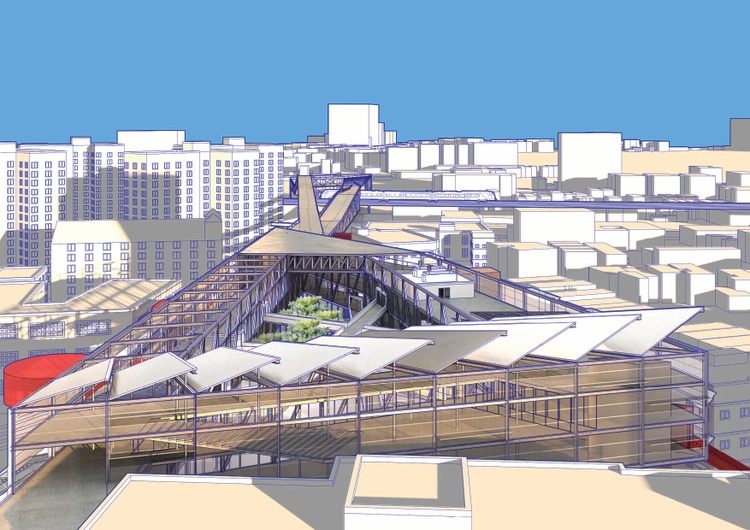Why CDA Architects Are Leaders in Architectural Layout and Development
Why CDA Architects Are Leaders in Architectural Layout and Development
Blog Article
Understanding the Collaborative Refine Between Engineers and Designers in Modern Construction Projects
The collaborative process in between architects and designers is essential in contemporary construction jobs, as it integrates design intent with design feasibility. Discovering these characteristics exposes insights that can substantially impact job outcomes and general market requirements.
The Value of Cooperation
The collaborative harmony between engineers and engineers is necessary for the successful realization of any kind of building and construction job. This partnership combines distinct competence and viewpoints, making it possible for the combination of cutting-edge design with functional design remedies. By interacting, engineers and designers can ensure that a job not just satisfies aesthetic and useful demands yet also sticks to safety, sustainability, and monetary restraints.
Collaboration promotes a common vision, promoting the alignment of objectives and expectations from the outset. This alignment is crucial in addressing potential obstacles and mitigating risks that can develop throughout the job lifecycle. In addition, a collective method permits the efficient allotment of resources, optimizing both time and cost.
The significance of collaboration includes the iterative procedure of design and building and construction, where responses from engineers can notify architectural choices, resulting in more possible and sustainable styles. Alternatively, engineers can inspire designers to think creatively regarding exactly how to attain structural stability without jeopardizing artistic intent. Eventually, the joint relationship in between designers and designers is not merely beneficial; it is essential to the production of high-quality, useful, and innovative constructed atmospheres that fulfill the needs of culture.
Communication Strategies and Tools
Efficient interaction strategies and devices are important for cultivating cooperation between designers and designers throughout the project lifecycle. Establishing clear networks of communication is vital to make certain that all employee are aligned with job objectives, timelines, and obligations. Routine conferences, both in-person and online, offer possibilities for stakeholders to discuss development, address issues, and make notified decisions.

Additionally, embracing collaborative interaction tools, such as Slack or Microsoft Teams, permits immediate messaging, documents sharing, and recurring discussions, promoting a more active action to arising issues. Record monitoring systems likewise play a vital duty in arranging project documents, guaranteeing that all group members have accessibility to the most up to date details.
Shared Objectives and Job Vision
An unified job vision offers as the structure for successful collaboration between designers and engineers (cda architects). This shared vision not only aligns the efforts of both parties however also develops an usual structure for decision-making throughout the job's lifecycle. By expressing clear objectives, stakeholders can efficiently browse the intricacies of modern-day construction projects, making sure that both visual and useful requirements are fulfilled
Developing common objectives involves open discussion and a complete understanding of each technique's payments. Designers commonly concentrate on style intent, spatial partnerships, and customer experience, while designers emphasize structural honesty, systems capability, and conformity with policies. When these point of views are aligned, the outcome is a cohesive task that follows both innovative goals and pop over here technical expediency.
In addition, a well-defined task vision promotes accountability among team members, motivating each participant to take possession of their role in achieving the wanted end result. Normal check-ins and collective workshops can additionally enhance this commitment, permitting for modifications to be made as the task progresses. Ultimately, a shared vision not just enhances team effort yet also boosts the high quality of the final deliverable, leading to effective job conclusion.
The Duty of Technology
Leveraging technology has actually ended up being vital in enhancing collaboration in between architects and engineers. Building Details Modeling (BIM) stands out as an essential innovation, enabling both designers and designers to produce detailed 3D designs that encapsulate design intent and structural stability.
Furthermore, cloud-based systems make it possible for seamless cooperation, enabling project stakeholders to access and upgrade project information from anywhere. This fosters a culture of openness and responsibility, as adjustments can be tracked my blog and examined in real-time. Additionally, mobile applications further enhance communication, supplying on-site teams with instant accessibility to task specifications and updates.
Arising technologies such view it now as synthetic intelligence and machine discovering are likewise starting to play a role in predictive evaluation, aiding groups recognize prospective issues prior to they develop. Eventually, the duty of modern technology in architecture-engineering partnership not only enhances workflow effectiveness however likewise improves technology, leading to more effective task outcomes. By accepting these technological innovations, designers and engineers can guarantee an extra natural and effective joint process throughout the construction lifecycle.
Situation Studies in Effective Partnerships
Many case researches show the extensive impact of efficient collaborations between architects and designers on task results. One remarkable instance is the cooperation on the High Line in New York City, where landscape designers, engineers, and city organizers worked together to transform an abandoned rail line right into a lively public park. This multidisciplinary method not only boosted the visual top quality yet likewise guaranteed structural safety and environmental sustainability.

The Burj Khalifa in Dubai even more shows the significance of joint efforts - cda architects. The combination of design and engineering knowledge made it possible for the project team to achieve unmatched heights while sticking to security laws and visual vision
These examples emphasize the importance of interaction, depend on, and shared objectives. In today's intricate building and construction setting, such partnerships are important to browsing difficulties and providing projects that satisfy both functional and visionary objectives.
Conclusion
Finally, the cooperation in between architects and designers is vital for the success of modern-day building tasks. Effective communication methods, a common job vision, and the assimilation of advanced technologies are important parts that promote this partnership. By promoting a society of responsibility and leveraging devices such as Building Information Modeling (BIM), teams can navigate project complexities, guaranteeing that aesthetic, practical, and sustainability purposes are accomplished. Inevitably, this harmony results in innovative and effective task end results.
Report this page